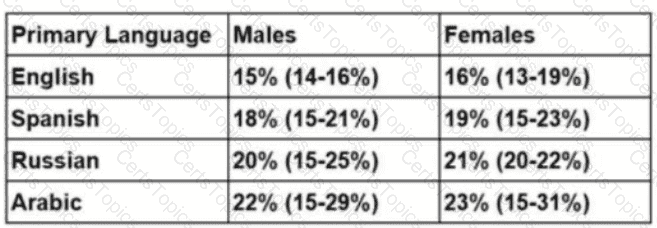The goal is to identify the group with the greatest disparity in 30-day readmission rates for heart failure patients, focusing on primary language and gender, to prioritize interventions for reducing disparities. NAHQ CPHQ study materials emphasize that addressing disparities in population health involves targeting groups with the highest rates of adverse outcomes, such as readmissions, to achieve health equity. Disparities are often influenced by social determinants of health, including language barriers, which can affect communication, understanding of discharge instructions, and access to follow-up care.
The data shows readmission rates by language and gender, with 95% confidence intervals indicating the range of uncertainty around the point estimates. Let’s analyze the rates:
English: Males 15% (14-16%), Females 16% (13-19%)
Spanish: Males 18% (15-21%), Females 19% (15-23%)
Russian: Males 20% (15-25%), Females 21% (20-22%)
Arabic: Males 22% (15-29%), Females 23% (15-31%)
First, compare the point estimates across groups. Arabic-speaking patients have the highest readmission rates: 22% for males and 23% for females, followed by Russian-speaking patients at 20% for males and 21% for females. English-speaking patients have the lowest rates at 15% for males and 16% for females. The confidence intervals show overlap between groups (e.g., Arabic males 15-29% overlaps with Russian males 15-25%), but the point estimates provide a clear ranking, with Arabic speakers consistently highest.
To assess disparities, calculate the overall rates for language groups by averaging male and female rates (since the options include “All Arabic speakers” and “All Russian speakers”):
Russian speakers: (20% + 21%) / 2 = 20.5%
Spanish speakers: (18% + 19%) / 2 = 18.5%
English speakers: (15% + 16%) / 2 = 15.5%
Arabic speakers have the highest average readmission rate (22.5%), indicating the greatest disparity compared to English speakers (15.5%), a difference of 7 percentage points. Russian speakers have a 20.5% average rate, a 5-point difference from English speakers.
Now, compare the gender-specific options: Arabic-speaking females (A) have a rate of 23%, and Russian-speaking females (B) have a rate of 21%. While Arabic-speaking females have the highest single rate, the question asks for the priority group to reduce disparities, which often involves targeting the broadest group with the largest overall disparity. Option C, “All Arabic speakers,” encompasses both males (22%) and females (23%), with an average of 22.5%, making it the group with the most significant disparity across both genders. Option D, “All Russian speakers,” has a lower average rate (20.5%).
The confidence intervals, while wide for smaller groups like Arabic and Russian speakers, do not change the prioritization, as the point estimates consistently show Arabic speakers with the highest rates. NAHQ emphasizes targeting the group with the greatest disparity in outcomes to address health equity, particularly when language barriers (e.g., Arabic speakers) may contribute to higher readmissions due to communication challenges. Therefore, “All Arabic speakers” (C) should be the priority target for interventions, such as language-specific education or interpreter services, to reduce disparities in readmission rates.
[Reference: NAHQ CPHQ Study Guide, Population Health and Care Transitions Section, “Addressing Health Disparities in Readmissions”; NAHQ CPHQ Practice Exam, Population Health Data Analysis for Equity., , , , , , ]
